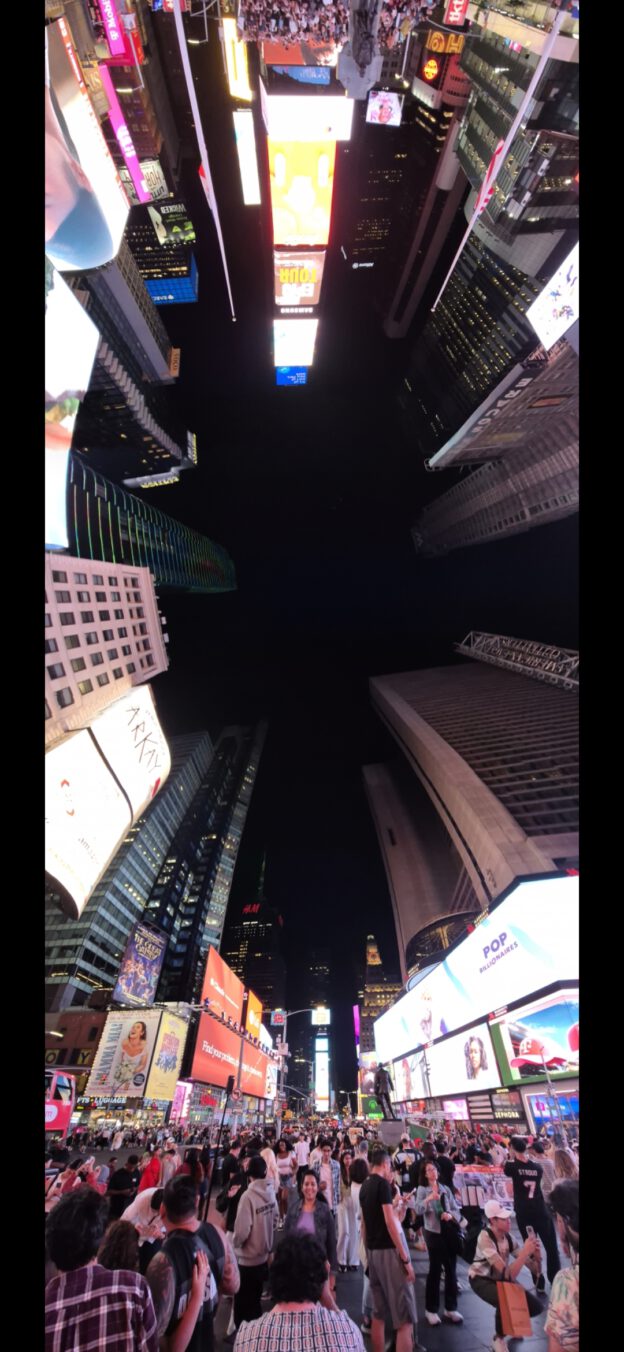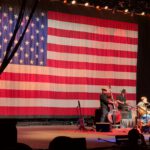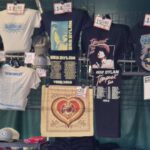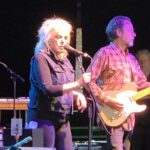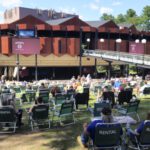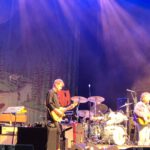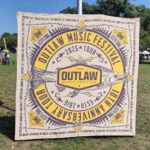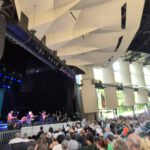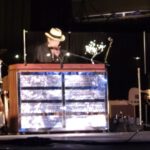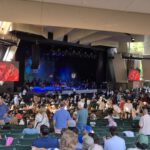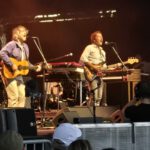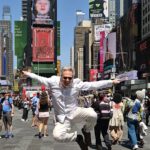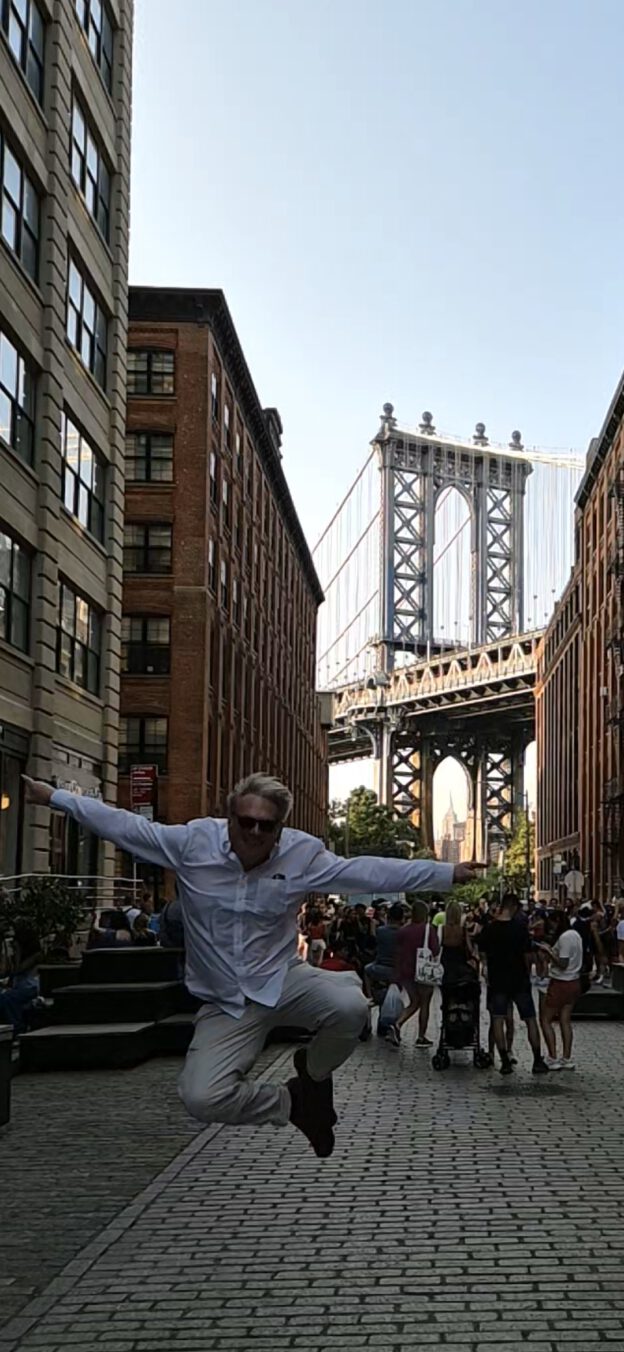
Archiv für den Monat: August 2025

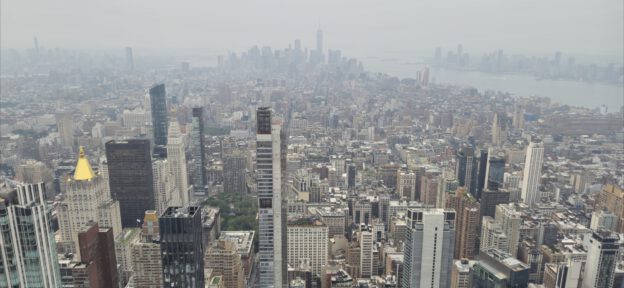
KW-33-2025: Back To New York City … Großstadt Impressionen
KW-33-2025: Back To New York City … Großstadt Impressionen
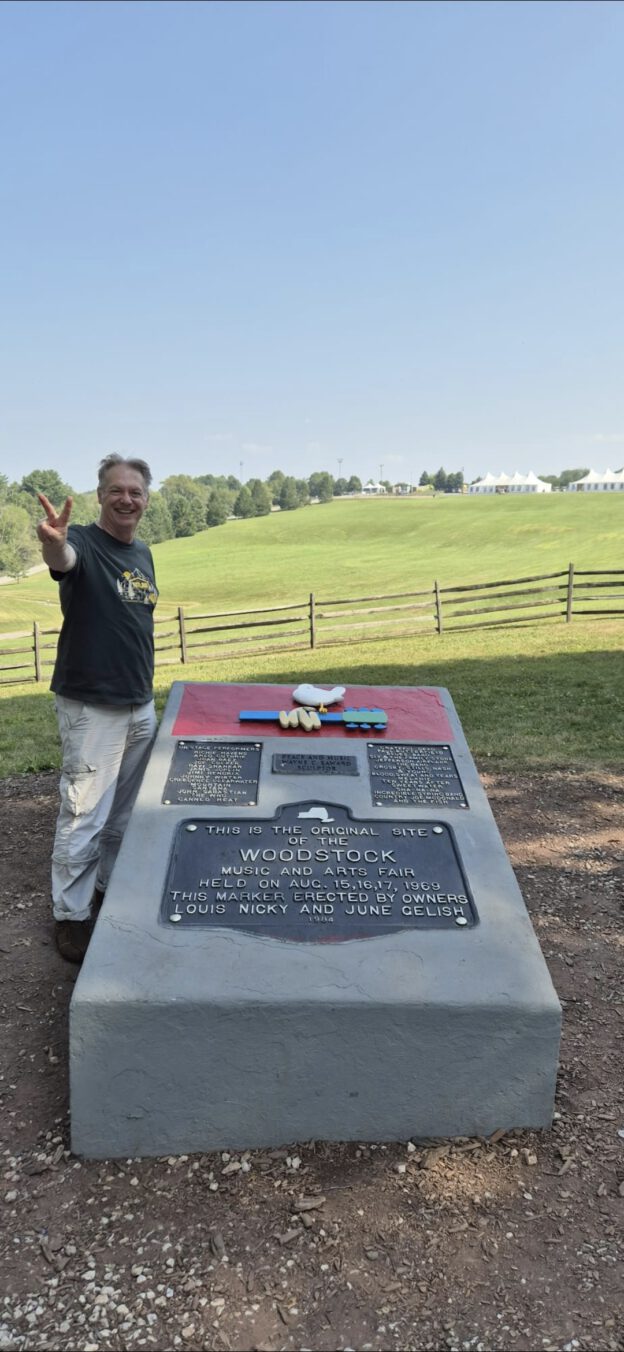
KW-32-2025: Visiting Woodstock 2025
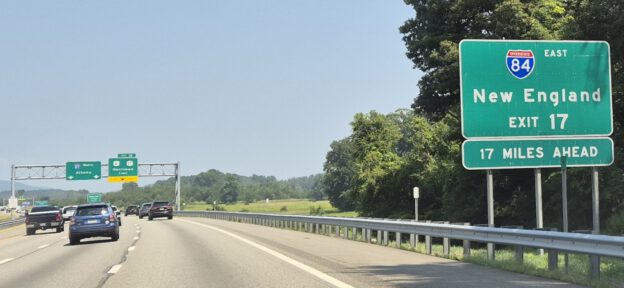
KW-32-2025: Up to the north from New York state To New England

KW-31-2025: „Bob Dylan-Konzerte in Amerika sind anders“ – Bob Dylan bei den Outlaw-Festival-Konzerten 2025 von Willie Nelson on the road again (Kapitel 1) – Live in Saratoga Springs, New York – Text & Fotos von Christof Graf (Engl./ German version)
„Bob Dylan-Konzerte in Amerika sind anders“ –
Bob Dylan bei den Outlaw-Festival-Konzerten 2025 von Willie Nelson on the road again (Kapitel 1) – Live in Saratoga Springs, New York, August 2nd 2025
Text & Fotos von Christof Graf
Der Besuch von Bob Dylan-Konzerte in den Vereinigten Staaten ist für einen Europäer anders als ein Besuch eines Bob Dylan-Konzertes für einen Europäer in Europa. Irgendwie habe ich als Europäer jedes Mal das Gefühl an die Wiege amerikanischen Liedgutes zu kommen, wenn ich ein Dylan-Konzert in Nordamerika besuche.
Und es ist anders, Bob Dylan bei einem dieser Outlaw Music Festival von Willie Nelson zu erleben. Ja, diese Dylan-Konzerte sind auch anders, als Dylans Solo-Konzerte in den Staaten. Zudem sind sie auch kürzer und dauern in der Regel etwa 75 Minuten. Und ja, auch die Setlists sind anders und folgen nicht der Songabfolge bei den Konzerten der „Rough And Rowdy Ways“-Tour.
Wie schon 2017 zum ersten Mal und 2024 zum zweiten Mal, ist Bob Dylan 2025 nun zum dritten Mal wieder bei Willie Nelsons musikalischem „Wanderzirkus“ durch die Staaten dabei. Das Konzept der „Outlaw Music Festivals“ ist einfach wie auch genial. Das Outlaw Music Festival ist ein wiederkehrendes Musikfestival, das von Willie Nelson gegründet wurde und bei dem er und seine Familie zusammen mit anderen Künstlern an verschiedenen Orten in den Vereinigten Staaten auftreten. Das Festival ist keine Einzelveranstaltung, sondern eine Tournee mit wechselnden Musikern. Das Outlaw Music Festival ist eine seit 2016 jährliche Veranstaltung, die Willie Nelsons Leben und Vermächtnis feiert und in verschiedenen Städten im ganzen Land stattfindet. Der mittlerweile 92jährige US-amerikanische Country-Sänger, Gitarrist, Songwriter und „Highwayman“ zählt zu den bedeutendsten Persönlichkeiten der sogenannten Outlaw-Bewegung und des Genres im Allgemeinen, deren Wurzeln in den 1960er Jahren des 20. Jahrhunderts liegen. Die Bewegung versammelte Musiker, die sich von den „kommerziellen Fesseln“ Nashvilles lösten und ihre eigene Musik spielen wollten. Willie Nelson & Family sind die Hauptdarsteller dieser Festivalserie, aber auch andere Künstler wie z.B. 2025 eben auch Bob Dylan sind bei verschiedenen Stopps vertreten. 2025 feiert das Festival sein 10-jähriges Jubiläum. Und genau diese geschichtliche Atmosphäre inklusive Willie Nelsons Einsatz für die Legalisierung von Cannabis umgeben diese Festivals.
Aber genug der Vorab-Philosophie, „Don’t Think Twice, It’s All Right“, wie der letzte von 17 Songs beim 75minütigen Auftritt von Bob Dylan in Saratoga Springs heißt. Für mich war eindeutig Dylans Auftritt der dortige Highlight des 37 Grad Celsius heißen Tages.
Pünktlich um 15.00 Uhr werden die Tore geöffnet und jeder sucht zunächst nach seinen Plätzen in der überdachten amphitheaterähnlichen Bühnenkonstruktion, bevor sich die obgligatorischen Schlangen am Merchandising-Stand bilden. Andere besorgen sich Liegestühle, um auf dem Grün vor dem Amphitheater ihre Blicke auf die mit dem Outlaw-Logo versehene Bühne zu richten. Auch dort kann man ohne allzu viel Klangverlust hinnehmen zu müssen, dem Musikgenuss folgen. Die Akustik auf dem Saratoga-Gelände ist wirklich außergewöhnlich gut, auch wenn man etwas abseits oder außerhalb der überdachten aber dennoch luft-offenen Arena das Geschehen beobachtet. Waylon Payne von Willie Nelsons Begleitband eröffnet um 16.00 für gut eine halbe Stunde den Konzerttag. Schon 20 Minuten später betritt die mit herzlichem Applaus willkommen geheißene Lucinda Williams die Bühne. Ich kenne mich in ihrem Werk nicht wirklich gut aus, hatte aber das Gefühl, das viele im Publikum damit sehr vertraut sind. Schon bei den jeweils ersten Tönen von Songs wie z.B. dem Opener „Real Live Bleeding Fingers and Broken Guitar Strings“ oder „West Memphis“ oder „Lowlife“ spendet das Publikum Vorabapplaus. „Stolen Moments“ von Tom Petty und „While My Guitar Gently Weeps“ von den Beatles erkenne ich sehr schnell. Eine Stunde dauert ihr Set bei dem sie fast unbeweglich oder sich nur ganz langsam bewegend in der Nähe des Mikrofonständers aufhält, während der Rest ihrer Band Vollgas gibt. – Folgen ihres Schlaganfalls im Jahre 2020, der sie am Spielen ihrer geliebten Gitarre abhält. – Beim „Mitrocken“ von Neil Youngs „Rockin In The Free World“, ein Klassiker, den ihre Band fast wie das Original in Szene setzt, merkt man ihr die Tatsache, dass sie nach dem Schlaganfall erst einmal neu Laufen lernen musste, kaum an. Die Standing Ovations für die Grand Dame des us-amerikanischen Roots-Rock- und Alternative Country Rock nach dem Schlussakkord sind mehr als angebracht.
Nach einer 25-minütigen Pause stehen Wilco aus Chicago auf der Bühne. Sie sind für ihre individuelle Form des Indie- und Alternative Country-Rocks berühmt. Auch sie haben eine „Story To Tell“, so der Opener ihres 75-Minuten-Sets, zu erzählen. Unglaublich, gelegentlich gar unerträglich laut ist es bei dem 16-Song-Konzert. Bei den letzten beiden Songs steht Willie Nelsons Mundharmoniker-Spieler Mickey Raphael mit Wilco auf der Bühne. Spätestens bei „Impossible Germany“ und beim letzten Song, dem „Grateful Dead“-Cover „U.S. Blues“ beginne ich mich an diesem Abend in die Musik von Wilco zu verlieben und an jene von „The Grateful Dead“ zu gedenken. Als Dylan am Tag zuvor in Wantagh aufrat, wäre es der 83. Geburtstag von Jerry Garcia gewesen. Acht Tage nach Saratoga, wenn Dylan in Hershey auftreten würde, würde es der 30. Todestag von Jerry Garcia sein. – Gerade diese beiden Songs haben für mich an diesem Abend etwas Tiefgründiges. Beim ersten Hinhören ist nicht alles sofort verständlich, manchmal wirkt es auch nicht sinnvoll. Die Musik wirkt auf mich nicht leicht eingängig, eher etwas transzendental und offeriert in jedem Song etwas Mehrdeutiges. Das daraus bei mir entstandene Gefühl für diese Konzertatmosphäre an diesem heißen Sommerabend des 2. Augusts passt sehr gut zu meiner Vorfreude auf Bob Dylan.
Sein Auftritt ist ein Fest. Dylan eröffnet den Saratoga-Auftritt mit dem schon seit ewigen Zeiten nicht mehr live gehörten „Positively 4th Street“.
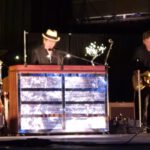 Als Dylan pünktlich um 20:05 auf die Bühne kommt, ist es auf dem SPAC-Areal noch hell. Knapp eine Stunde zuvor fuhr Bobs Tourbus leftstage an den Bühnenrand. Im letzten Jahr verweigerte sich Dylan vor dem Outlaw-Festival-Tour-Logo zu spielen. In diesem Jahr verweigert er sich nicht und lässt es zu, vor dem „10th Anniversary Tour Logo“ zu spielen. Sein Bühnen-Equipment ist im Gegensatz zu Lucinda Willimas und Wilcos im hinteren Bereich, fernab des vorderen Bühnenrandes aufgebaut. Bobs Piano ist in der Bühnenmitte aufgestellt. Links davon steht Bob Britt an der elektrischen Gitarre, rechts von ihm Doug Lancio, der zunächst akustische Gitarre spielt. Im Hintergrund von Bob hält Tony Garniers Elektrik-Bass und Anton Figs Schlagzeugspiel den Song zusammen. Licht gibt es nicht allzu viel und war auch nicht von Nöten. Es war noch hell und lediglich vier kleine Hintergrundlampe wirken wie Strassenlichter. Das dezent angestrahlte Outlaw-Motiv sorgt für eine ungewöhnlich helle Bühnenatmosphäre, im Vergleich zu seinen Rough And Rowdy ways-Auftritten.
Als Dylan pünktlich um 20:05 auf die Bühne kommt, ist es auf dem SPAC-Areal noch hell. Knapp eine Stunde zuvor fuhr Bobs Tourbus leftstage an den Bühnenrand. Im letzten Jahr verweigerte sich Dylan vor dem Outlaw-Festival-Tour-Logo zu spielen. In diesem Jahr verweigert er sich nicht und lässt es zu, vor dem „10th Anniversary Tour Logo“ zu spielen. Sein Bühnen-Equipment ist im Gegensatz zu Lucinda Willimas und Wilcos im hinteren Bereich, fernab des vorderen Bühnenrandes aufgebaut. Bobs Piano ist in der Bühnenmitte aufgestellt. Links davon steht Bob Britt an der elektrischen Gitarre, rechts von ihm Doug Lancio, der zunächst akustische Gitarre spielt. Im Hintergrund von Bob hält Tony Garniers Elektrik-Bass und Anton Figs Schlagzeugspiel den Song zusammen. Licht gibt es nicht allzu viel und war auch nicht von Nöten. Es war noch hell und lediglich vier kleine Hintergrundlampe wirken wie Strassenlichter. Das dezent angestrahlte Outlaw-Motiv sorgt für eine ungewöhnlich helle Bühnenatmosphäre, im Vergleich zu seinen Rough And Rowdy ways-Auftritten.
„Positively“ ist die bisher erste Änderung der Setlist beim zweiten Teil der 2025er-Outlaw-Tour. Bei den fünf vorangegangen Konzerten des zweiten Tour-Teils war es „Gotta Serve Somebody“, der die Shows eröffnete.
Nach „Positively“ folgt mit „I Can Tell“ ein erstes Cover. Das Original stammt von Samuel Smith. Hierfür wechselt Doug Lancio von der akustischen zur elektrischen Gitarre. Der R`n`B- hafte Song steht für Dylans Spielfreude und dessen glasklaren Gesang an diesem Abend.
Mit „Forgetful Heart“ verliert sich Dylan in seiner eigenen Improvisationslust. Die Band achtet penibel auf die Wortdehnungen und Tastenvariationen ihres Chefs. Blickkontakte zwischen den Musikern sind bis dahin nicht beobachtbar und hörbar. Notwendig sind sie auch nicht. Das Konzert ist im Fluss. Die Musiker sind bestens auf sich eingestellt. Dylan spielt und singt stehend hinter seinem Klavier, ohne einen Blick ins Publikum zu richten. Eine Art Lichterkranz auf dem Klavier verdeckt zuweilen sein Gesicht. Das Klavier ist eingekleidet von reflektierenden Silberplatten.
„Axe And The Wind“, ist ein weiteres Cover. Das Original stammt von George „Wild Child“ Butler und integriert sich nahtlos in die Blues-Stimmung des Songs. Dylan spielt erstmals Mundharmonika am Ende des Songs.
Bei „To Ramona“ gibt es bei Doug wieder einen Gitarrenwechsel von der E- zur A-Gitarre. Tony Garnier greift zum Stand Up-Bass. Dylan trägt „To Ramona“ geradezu gefühlvoll, besinnlich und auch erstmals an diesem Abend sitzend vor. Das Publikum, das sich beim sonst geradezu obligatorischen Bierholen während der Auftritte bei Dylan tatsächlich etwas mäßigte, begann bei dem Folk-Walzer mitzuschunkeln.
In der Vergangenheit war es oft so, dass Dylan sich stimmlich erst finden musste und dies erst nach einigen Songs gelang. In Saratoga hat sich Dylan von der ersten Minute an gefunden und intoniert eigenes wie auch fremdes Song gut, respektvoll und ausgeglichen. Fast scheint das Konzert wie kein anderes zuvor geradezu konstruiert zu sein. Stimmverluste, Interpretationsfehler und unkoordiniertes Zusammenspiel sind einfach nicht geplant und nicht einkalkuliert. Das Konzert strebt schon nach „Under The Red Sky“ einer gewissen präzisen Perfektion entgegen. Bob steht wieder auf, nicht aber ohne seine Position zu verlassen. Fast wirkt Bob Dylan wie verschmolzen mit seinem Klavier. An das freistehende Stand-Mikrofon schreitet er nicht. Dylan im schwarzen Anzug mit dunklem gemusterten Hemd und hellbeigem Edel-Stetson-Hut mit schwarzem Hutband bleibt hinterm dem Klavier stehen. Manchmal spielt er mit der rechten Hand kurz Mundharmonika, wie z.B. bei dem Song „I`ll Make It All Up To You“ von Charlie Rich, dem dritten Cover-Song des Abends. Spätestens jetzt merkt man Dylans Spielfreude wirklich an. Er setzt sich kaum und wiegt sich in die Rhythmen seiner von ihm selbst inszenierten Musik. Er schaut nun gelegentlich ins Publikum und wechselt auch Blicke mit Bob, Tony und Doug.
Und dann kommt sie wieder. Die oft zitierte, zunächst unerkannt bleibende Einführung eines Songs, die sich dann aus dem Unbekannten ins Bekannte eines Songs herausschält. In diesem Fall gehört sie „All Along The Watchtower“. Dylan improvisiert auf seinen Tasten, um einem alten Lied einen neuen Groove zu geben. Die Gitarristen legen Soli drüber, bis der Chef wieder bremst und dem Song wieder sein Korsett anlegt.
„Till I Fell in Love With You“, „Desolation Row“ und „Love Sick“ sind drei weitere Dylan-Originale, denen ihr Schöpfer neue musikalische Gewänder anlegt. Bei „Till“ bringt Bob den Blues ins Haus. Fast schaffen es die fünf Musiker Big Band-Blues-Sound im Chicago-Style zu erzeugen. – Herrlich. „Desolation“ ist nach „Along“ ein zweiter Höhepunkt mit positivem Überraschungscharakter. Der Song, sitzend vorgetragen, lässt Raum für eine weitere von mehreren kleinen wie Jam-Sessions klingende Song-Passagen. Geradezu vorsichtig hängt sich die Band ausnahmslos mit akustischen Instrumenten an Dylans vorgegebenes Tempo an und lässt ihren Chef dort improvisieren, wo er es gerade möchte. Seine Stimme wirkt zeitweise nur sprechend oder gar flüsternd, als würde er sich sowohl auf die Artikulation von Wort und Inszenierung von Ton gleichgewichtig konzentrieren, um ja keinen Fehler dabei zu machen. „Desolation“ scheint Bob Dylan an diesem Abend besonders wichtig zu sein. „Love Sick“ ist für mich wichtiger. Ich liebe diesen Blues-Rock- Song vom 1997er „Time Out Of Mind“-Album über alles, für den Dylan wieder aufsteht. Die Band wird wieder elektrischer und etwas lauter. Beim Blick zurück ins Publikum und nach draussen auf die Location umgibt die „Broadview Stage“ ein sommerliches Abendlicht. Bierholen gehen wenige. Dylan fesselt mit Spiel und Gesang.
Beim anschließenden „Share Your Love With Me“ kann mein nicht sehr kommunikativer rechter Sitznachbar seinen vermeintlichen Unmut über die Setlist dann doch nicht mehr verbergen. „Wieder nur ein Cover“, ruft er enttäuscht über den Song aus der Feder von Alfred Braggs und Deadric Malone. „Vielleicht möchte Dylan im Anschluß der Tour ein Outlaw-Live-Album mit Coverversionen im Americana-style veröffentlichen“, rufe ich zurück. Es ist der dreizehnte Song des Abends.
Eine geradezu betörend und zärtlich vorgetragene so von mir noch nicht gehörte Version von „Blind Willie McTell“ trägt Dylan wieder sitzend vor. „Blind“ bekommt plötzlich etwas jazz-haftes. Antin Fig streicht mit seinen Trommelstöcken geradezu zärtlich über die Trommelfelle und stabilisiert den von Tony Garnier am Stand Up-Bass vorgegebenen Rhythmus gefühlvoll.
Tony beginnt nach dem Song an zu wippen. Dylan steht auf. Das Schlagzeug wird lauter. Die Band wird lauter. Der Sound explodiert im „Highway 61 Revisited“-Song. Der dritte Highlight in einem Highlight-Konzert. Schwungvoll, wie ein alter Dieselmotor, im Rhythmus gleichbleibend und zuverlässig das Tempo haltend macht der Song Lust auf die gute alte Zeit, wann immer die auch war und egal, wie gut sie damals tatsächlich war. Unerwartet und neu: Bob stellte seine Band nicht vor, wie er es am Tag zuvor in Wantagh nach „Highway“ tat.
„Searching For A Soldier`s Grave“ lässt mich wieder zu meinem Nachbarn schauen. Der zuckt nur mit den Schultern, als wir das fünfte Cover des Abends hören. „Der Mann hat über 600 Songs geschrieben, warum trägt er uns so viele von anderen vor. Ich kann es nicht verstehen“, ruft er mir rüber. Ich zucke nur mit den Schultern. Draußen ist es dunkel und ich denke mir nur: „Don`t Think Twice, It’s All Right“, als ich die ersten Zeilen des letzten Songs von Bobs Auftritt in Saratoga höre. Wieder baut Dylan eine Brücke von der Vergangenheit in die Gegenwart. Er spricht den Song mehr als er ihn singt. Bei dieser gegenwärtigen Interpretation schafft es Dylan, alte Orte in der Dylan`schen Songlandschaft für uns neu zu erkunden. Brillant. Ein perfektes Finale für ein perfektes Konzert zwischen Original und Neufassung, von wem auch immer Original und Neufassung sind.
75 Minuten nach dem Konzertbeginn ist Schluss. Dylan steht nach einem kurzen Mundharmonika-Spiel bei „Don`t Think“ am Ende des Songs auf, stellt sich kurz zu Tony Garnier und verlässt ohne ein Wort ans Publikum zu richten die Bühne. Das Licht geht aus. Die Stage-Crew beginnt die Bühne für Willie Nelson vorzubereiten.
Der Abend ist im Fluß. Die Gemeinde wagt es endlich wieder Wasser zu lassen und neues zu holen, bevor der 92jährige Wille Nelson 30 Minuten später pünktlich um 21:50 Uhr die Bühne mit Band betritt. Im Hintergrund ist nun wie im vergangenen Jahr die bühnengroße „Stars & Stripes“-Flagge zu sehen. Der zuvor aufgehängte Bühnenvorhang fällt und Willie Nelson beginnt sein einstündiges Konzert mit Klassikern wie „Georgia On My Mind“, „Roll Me Up and Smoke Me When I Die“ oder „On The Road Again“.
P.S.: Auf dem Rückweg nach „New York City“ lese ich Schilder wie „Woodstock“, „Saugerties“ oder auch „Bethel. Ich weiß, dass dieser Outlaw-Festival-Konzertabend an der Ost-Küste der USA nicht mein letzter in diesem Jahr sein wird, noch immer Dylans „Highway 61“ und Nelsons „On The Road Again“ im Ohr. Und ein Besuch im „Bethel Woods Center for the Arts“ und im dortigen Woodstock-Museum sollte auf meinem US-East-Coast-Trip 2025 nicht fehlen.
„Bob Dylan concerts in America are different“ – (engl. version)
Bob Dylan at Willie Nelson’s 2025 Outlaw Festival Concerts on the Road Again (Chapter 1) – Live in Saratoga Springs, New York
Text & Photos by Christof Graf
Attending Bob Dylan concerts in the United States is different for a European than attending a Bob Dylan concert for a European in Europe. Somehow, as a European, I have the feeling of coming to the cradle of American songs every time I attend a Dylan concert in North America.
And it’s different to experience Bob Dylan at one of these Willie Nelson Outlaw Music Festivals. Yes, these Dylan concerts are also different from Dylan’s solo concerts in the States. They are also shorter and usually last about 75 minutes. And yes, the setlists are also different and don’t follow the song sequence at the concerts of the „Rough And Rowdy Ways“ tour.
As in 2017 for the first time and in 2024 for the second time, Bob Dylan will be back in Willie Nelson’s musical „traveling circus“ through the States for the third time in 2025. The concept of the „Outlaw Music Festivals“ is simple as well as ingenious. The Outlaw Music Festival is a recurring music festival founded by Willie Nelson where he and his family, along with other artists, perform in various venues across the United States. The festival is not a single event, but a tour with changing musicians. The Outlaw Music Festival has been an annual event since 2016 that celebrates Willie Nelson’s life and legacy, taking place in various cities across the country. The now 92-year-old American country singer, guitarist, songwriter and „highwayman“ is one of the most important personalities of the so-called outlaw movement and the genre in general, whose roots lie in the 1960s of the 20th century. The movement gathered musicians who wanted to break free from the „commercial shackles“ of Nashville and play their own music. Willie Nelson & Family are the main actors of this festival series, but other artists such as Bob Dylan in 2025 are also represented at various stops. In 2025, the festival celebrates its 10th anniversary. And it is precisely this historical atmosphere, including Willie Nelson’s commitment to the legalization of cannabis, that surrounds these festivals.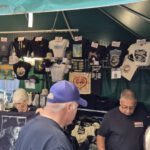 But enough of the advance philosophy, „Don’t Tink Twice, It’s All Right“, as the last of 17 songs at Bob Dylan’s 75-minute performance in Saratoga Springs is called. For me, Dylan’s appearance was clearly the highlight of the 37 degree Celsius hot day.
But enough of the advance philosophy, „Don’t Tink Twice, It’s All Right“, as the last of 17 songs at Bob Dylan’s 75-minute performance in Saratoga Springs is called. For me, Dylan’s appearance was clearly the highlight of the 37 degree Celsius hot day.
The gates open punctually at 3:00 p.m. and everyone first looks for their seats in the covered amphitheater-like stage construction before the obligatory queues form at the merchandising stand. Others get deck chairs to direct their eyes to the stage with the Outlaw logo on the green in front of the amphitheater. There, too, you can follow the music enjoyment without having to accept too much loss of sound. The acoustics on the Saratoga grounds are really exceptionally good, even if you watch the action a little away or outside the covered but still air-open arena. Waylon Payne from Willie Nelson’s backing band opens the concert day at 4:00 p.m. for a good half hour. Just 20 minutes later, Lucinda Williams, welcomed with warm applause, enters the stage. I don’t really know much about her work, but I had the feeling that many in the audience are very familiar with it. Already with the first notes of songs such as the opener „Real Live Bleeding Fingers and Broken Guitar Strings“ or „West Memphis“ or „Lowlife“ the audience applauds in advance. „Stolen Moments“ by Tom Petty and „While My Guitar Gently Weeps“ by „The Beatles“ I recognize very quickly. Her set lasts an hour, during which she stays almost motionless or only moving very slowly near the microphone stand, while the rest of her band goes full throttle. – consequences of her stroke in 2020, which prevents her from playing her beloved guitar. – During the „Mittrocken“ of Neil Young’s „Rockin In The Free World“, a classic that her band stages almost like the original, you hardly notice the fact that she had to learn to walk again after the stroke. The standing ovations for the grand dame of US roots rock and alternative country rock after the final chord are more than appropriate.
After a 25-minute break, Wilco from Chicago are on stage. They are famous for their individual form of indie and alternative country rock. They also have a „Story To Tell“ to tell, according to the opener-song of their 75-minute set. Unbelievable, occasionally even unbearably loud is the 16-song concert. For the last two songs, Willie Nelson’s harmonic player Mickey Raphael is on stage with Wilco. At the latest with „Impossible Germany“ and the last song, the „Grateful Dead“ cover „U.S. Blues“, I begin to fall in love with the music of Wilco and think of that of „The Grateful Dead“. When Dylan shows up in Wantagh the day before, it would have been Jerry Garcia’s 83rd birthday. Eight days after Saratoga, when Dylan performed in Hershey, it would be the 30th anniversary of Jerry Garcia’s death. – Especially these two songs have something profound for me this evening. At first listening, not everything is immediately understandable, and sometimes it doesn’t seem to make sense. The music doesn’t seem easy catchy to me, rather a bit transcendental and offers something ambiguous in every song. The resulting feeling for this concert atmosphere on this hot summer evening of August 2 fits very well with my anticipation of Bob Dylan.
His appearance is a celebration. Dylan opens the Saratoga performance with „Positively 4th Street“, which has not been heard live for ages.
When Dylan comes on stage punctually at 8:05 p.m., it is still light on the SPAC grounds. Less than an hour earlier, Bob’s tour bus drove left-stage to the edge of the stage. Last year, Dylan refused to play in front of the Outlaw Festival tour logo. This year he does not refuse and allows himself to play in front of the „10th Anniversary Tour Logo“. In contrast to Lucinda Willimas and Wilcos, his stage equipment is set up in the back area, far away from the front edge of the stage. Bob’s piano is set up in the middle of the stage. To his left is Bob Britt on the electric guitar, to his right Doug Lancio, who initially plays acoustic guitar. In the background of Bob, Tony Garnier’s electric bass and Anton Fig’s drumming hold the song together. There is not too much light and was not necessary. It was still bright and only four small background lamps look like street lights. The subtly illuminated outlaw motif creates an unusually bright stage atmosphere, compared to his Rough And Rowdy ways performances.
„Positively“ is the first setlist change so far for the second part of the 2025 Outlaw Tour. At the five previous concerts of the second part of the tour, it was „Gotta Serve Somebody“ who opened the shows.
After „Positively“ follows with „I Can Tell“ a first cover. The original was written by Samuel Smith. For this, Doug Lancio switches from acoustic to electric guitar. The R’n’B-like song stands for Dylan’s joy of playing and his crystal-clear singing this evening.
With „Forgetful Heart“ Dylan loses himself in his own desire to improvise. The band pays meticulous attention to the word stretches and key variations of their boss. Eye contact between the musicians is not observable or audible until then. Nor are they necessary. The concert is in flux. The musicians are well attuned to themselves. Dylan plays and sings standing behind his piano, without looking at the audience. A kind of wreath of lights on the piano sometimes covers his face. The piano is clad in reflective silver plates.
„Axe And The Wind“, is another cover. The original was written by George „Wild Child“ Butler and integrates seamlessly into the blues mood of the song. Dylan plays the harmonica for the first time at the end of the song.
On „To Ramona“ Doug changes guitars from electric to electric guitar. Tony Garnier reaches for the stand-up bass. Dylan performs „To Ramona“ almost emotionally, contemplatively and also sitting down for the first time this evening. The audience, which actually moderated itself a bit during the otherwise almost obligatory beer fetching during Dylan’s performances, began to sway along to the folk waltz.
In the past, it was often the case that Dylan had to find himself vocally first and only succeeded after a few songs. In Saratoga, Dylan has found himself from the first minute and intones his own as well as someone else’s song well, respectfully and balanced. The concerto almost seems to be constructed like no other before. Loss of voice, interpretation errors and uncoordinated interaction are simply not planned and not taken into account. The concert is already striving for a certain precise perfection after „Under The Red Sky“. Bob gets up again, but not without leaving his position. Bob Dylan almost seems to have merged with his piano. He does not step up to the free-standing microphone. Dylan in a black suit with a dark patterned shirt and a light beige noble Stetson hat with a black hat band stops behind the piano. Sometimes he plays the harmonica with his right hand, as in the song „I’ll Make It All Up To You“ by Charlie Rich, the third cover song of the evening. At this point, at the latest, you can really notice Dylan’s joy of playing. He hardly sits down and sways into the rhythms of his music, which he has staged himself. He now occasionally looks at the audience and also exchanges glances with Bob, Tony and Doug.
And then she comes back. The often-quoted, initially unrecognized introduction of a song, which then peels out of the unknown into the familiar of a song. In this case, it belongs to „All Along The Watchtower“. Dylan improvises on his keys to give an old song a new groove. The guitarists put solos over it until the boss brakes again and puts his corset on the song again.
„Till I Fell in Love With You“, „Desolation Row“ and „Love Sick“ are three other Dylan originals to which their creator puts new musical garments. In „Till“, Bob brings the blues into the house. The five musicians almost manage to create big band blues sound in Chicago style. –Splendid. After „Along“, „Desolation“ is a second highlight with a positive surprise character. The song, performed seated, leaves room for another of several small song passages that sound like jam sessions. Almost cautiously, the band invariably clings to Dylan’s predetermined tempo with acoustic instruments and lets their boss improvise wherever he wants. At times, his voice only seems to speak or even whisper, as if he were concentrating on both the articulation of word and the staging of sound in equal measure, so as not to make a mistake. „Desolation“ seems to be particularly important to Bob Dylan this evening. „Love Sick“ is more important to me. I love this blues-rock song from 1997’s „Time Out Of Mind“ album more than anything, for which Dylan gets up again. The band becomes more electric and a bit louder again. Looking back into the audience and outside at the location, the „Broadview Stage“ is surrounded by a summery evening light. Few go to get beer. Dylan captivates with acting and singing.
During the following „Share Your Love With Me“, my not very communicative right-hand seat neighbor can no longer hide his supposed displeasure about the setlist. „Just another cover,“ he shouts disappointed about the song penned by Alfred Braggs and Deadric Malone. „Maybe Dylan would like to release an outlaw live album with cover versions in Americana style after the tour,“ I call back. It is the thirteenth song of the evening.
An almost beguiling and tenderly performed version of „Blind Willie McTell“, which I have never heard before, is recited by Dylan sitting again. „Blind“ suddenly gets something jazzy. Antin Fig strokes the eardrums almost tenderly with his drumsticks and sensitively stabilizes the rhythm set by Tony Garnier on the stand-up bass.
Tony starts bobbing after the song. Dylan stands up. The drums get louder. The band gets louder. The sound explodes in the „Highway 61 Revisited“ song. The third highlight in a highlight concert. Swinging, like an old diesel engine, consistent in rhythm and reliably keeping the tempo, the song makes you want to go back to the good old days, whenever they were and no matter how good they actually were back then. Unexpected and new: Bob did not introduce his band, as he did the day before in Wantagh after „Highway“.
„Searching For A Soldier’s Grave“ makes me look at my neighbor again. He just shrugs his shoulders when we hear the fifth cover of the evening. „The man has written over 600 songs, why does he perform so many of others. I can’t understand it,“ he calls over to me. I just shrug my shoulders. It’s dark outside and I’m just thinking to myself, „Don’t Think Twice, It’s All Right“ when I hear the first lines of the last song of Bob’s performance in Saratoga. Again, Dylan builds a bridge from the past to the present. He speaks the song more than he sings it. In this contemporary interpretation, Dylan manages to re-explore old places in Dylan’s song landscape for us. Brilliant. A perfect finale for a perfect concert between original and new version, by whomever the original and new version are.
75 minutes after the concert begins, it’s over. Dylan stands up after a short harmonica play on „Don’t Think“ at the end of the song, stands briefly next to Tony Garnier and leaves the stage without saying a word to the audience. The lights go out. The stage crew begins to prepare the stage for Willie Nelson.
The evening is flowing. The congregation finally dares to urinate again and fetch new ones, before 92-year-old Wille Nelson enters the stage with his band 30 minutes later punctually at 9:50 p.m. In the background, as in the previous year, the stage-sized „Stars & Stripes“ flag can now be seen. The previously hung stage curtain falls and Willie Nelson begins his one-hour concert with classics such as „Georgia On My Mind“, „Roll Me Up and Smoke Me When I Die“ or „On The Road Again“.
P.S.: On the way back to „New York City“ I read signs like „Woodstock“, „Saugerties“ or „Bethel. I know that this outlaw festival concert evening on the east coast of the USA will not be my last this year, still listening to Dylan’s „Highway 61“ and Nelson’s „On The Road Again“. And a visit to the „Bethel Woods Center for the Arts“ and the Woodstock Museum there should not be missed on my US East Coast trip in 2025.
